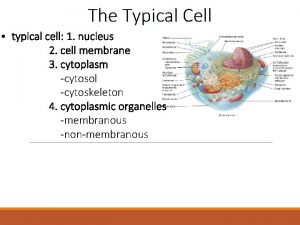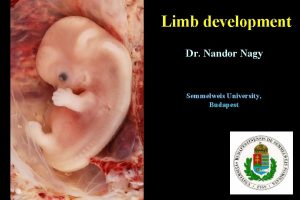Development of Face Dr Nndor Nagy Semmelweis University





















- Slides: 21

Development of Face Dr. Nándor Nagy Semmelweis University

aorta Neural tube gut

Fa ce The basic morphology of the face is established between the 4 th and 10 th weeks by the development and fusion of five prominences (processes)

4 th week -processus frontalis (frontonasal prominence) Nasal placod (Pax-6) -processus maxillaris -stomodeum (primitive oral cavity) (maxillary Prominences) -processus mandibularis (two mandibular prominence)




Nasal or olfactory placodes invaginates to form the nasal pit, dividing the frontonasal prominence into the lateral and medial nasal process. (Nasal placodes give rise to the olfactoty epithelium) Nasal pit maxillary prominences -proliferate and move toward the midline 5 -6 th week


7 th week eye Medial nasal process and maxillary process Upper lip: 2 Medial nasal process 2 processus maxillaris Lower lip: fusion of 2 mandibular process - Nasolacrimal groove: the ectoderm invaginates and form a duct, that is invested by bone during the ossification of the maxilla -fusion of the mandibular and lateral nasal process


The medial nasal processes fuse to form the septum of the nose and the intermaxillary process. The intermaxillary process give rise to the philtrum and the primary palate containing four incisor teeth.

the primary palate will form the premaxillary portion of the maxilla (anterior one-third of the final palate). This small portion is anterior to the incisive foramen and will contain the 4 maxillary incisors.

-Nasal sac develops from the nasal pits -rupture of the oronasal membrane form the primitive choana

Medial wall of the maxillary prominence form the palatine shelf

Cleft palate-(1: 2500) The spectrum of malformations ranges in severity from minor midfacial defects to extremely devastating malformations. Hall BK, Precious DS. Cleft lip, nose, and palate: the nasal septum as the pacemaker for midfacial growth. Oral Surg Oral Med Oral Pathol Oral Radiol. 2013 Apr; 115(4): 442 -7.


Bilateral cleft lip. This malformation results from failure of the medial nasal processes to fuse with the maxillary swellings (prominences, processes).

Multiplanar imaging in severe unilateral cleft lip and palate Three- and four-dimensional ultrasonography for the structural and functional evaluation of the fetal face. Asim Kurjak, Guillermo Azumendi, Wiku Andonotopo, Aida Salihagic-Kadic, Am J Obstet Gynecol 2007; 196: 16 -28.

Clefts of the palate are common birth defects requiring extensive treatment. They appear to be caused by multiple genetic and environmental factors during palatogenesis. This may result in local changes in growth factors, extracellular matrix (ECM), and cell adhesion molecules.

In this infant, there is a narrowing of the upper face and a single nostril (holoprosencephaly, affecting 1 in 16, 000 births)
 Hyperparathyreosis
Hyperparathyreosis Territorial matrix vs interterritorial matrix
Territorial matrix vs interterritorial matrix Semmelweis university faculty of medicine
Semmelweis university faculty of medicine Attributable silence
Attributable silence Brown and levinson 1987
Brown and levinson 1987 Face-to-face narrative examples
Face-to-face narrative examples What are the three elements of face to face communication
What are the three elements of face to face communication Face to face interview pros and cons
Face to face interview pros and cons Face theory brown and levinson
Face theory brown and levinson What shape
What shape Romeo and juliet onomatopoeia
Romeo and juliet onomatopoeia Phospholipid bilayer
Phospholipid bilayer Face to face class
Face to face class Corso ecdl
Corso ecdl Nagy sándor zanza
Nagy sándor zanza Testicular feminization syndrome
Testicular feminization syndrome Nagy gyula az én miatyánkom
Nagy gyula az én miatyánkom Nagy artézi medence
Nagy artézi medence Nagy istenem ha nézem a világot
Nagy istenem ha nézem a világot Kinézek az ablakon falevél egy nagy halom
Kinézek az ablakon falevél egy nagy halom Orosz cintia nagy ő
Orosz cintia nagy ő Pavol nagy sudca
Pavol nagy sudca








































